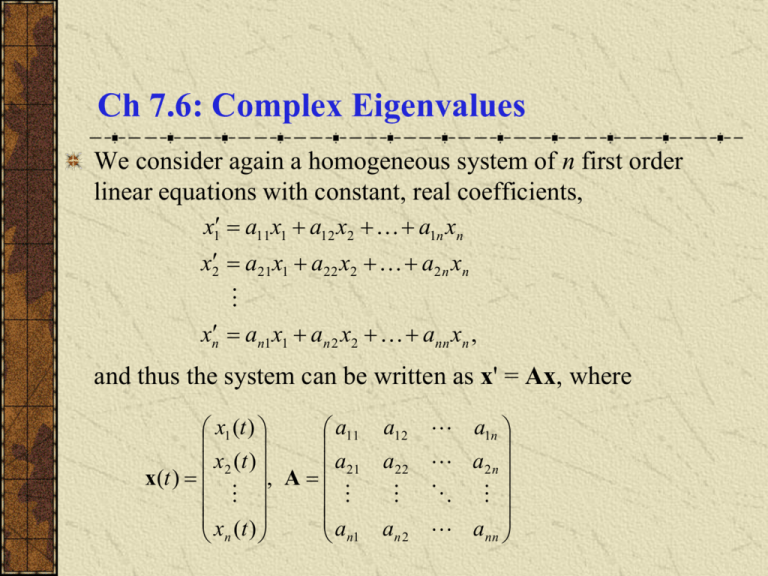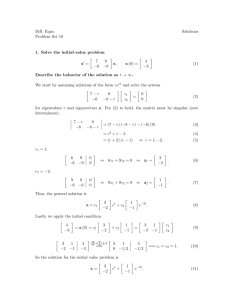7.6
advertisement

Ch 7.6: Complex Eigenvalues We consider again a homogeneous system of n first order linear equations with constant, real coefficients, x1 a11x1 a12 x2 a1n xn x2 a21x1 a22 x2 a2 n xn xn an1 x1 an 2 x2 ann xn , and thus the system can be written as x' = Ax, where x1 (t ) a11 a12 x2 (t ) a21 a22 x(t ) , A x (t ) a n n1 an 2 a1n a2 n ann Conjugate Eigenvalues and Eigenvectors We know that x = ert is a solution of x' = Ax, provided r is an eigenvalue and is an eigenvector of A. The eigenvalues r1,…, rn are the roots of det(A-rI) = 0, and the corresponding eigenvectors satisfy (A-rI) = 0. If A is real, then the coefficients in the polynomial equation det(A-rI) = 0 are real, and hence any complex eigenvalues must occur in conjugate pairs. Thus if r1 = + i is an eigenvalue, then so is r2 = - i. The corresponding eigenvectors (1), (2) are conjugates also. To see this, recall A and I have real entries, and hence A r1I ξ (1) 0 A r1I ξ (1) 0 A r2I ξ ( 2) 0 Conjugate Solutions It follows from the previous slide that the solutions x(1) ξ (1) e r1t , x( 2) ξ ( 2) e r2t corresponding to these eigenvalues and eigenvectors are conjugates conjugates as well, since x( 2) ξ ( 2) e r2t ξ (1) e r2t x (1) Real-Valued Solutions Thus for complex conjugate eigenvalues r1 and r2 , the corresponding solutions x(1) and x(2) are conjugates also. To obtain real-valued solutions, use real and imaginary parts of either x(1) or x(2). To see this, let (1) = a + ib. Then x (1) ξ (1) e i t a ib e t cos t i sin t e t a cos t b sin t ie t a sin t b cos t u(t ) i v(t ) where u(t ) e t a cos t b sin t , v(t ) e t a sin t b cos t , are real valued solutions of x' = Ax, and can be shown to be linearly independent. General Solution To summarize, suppose r1 = + i, r2 = - i, and that r3,…, rn are all real and distinct eigenvalues of A. Let the corresponding eigenvectors be ξ (1) a ib, ξ ( 2) a ib, ξ (3) , ξ ( 4) ,, ξ ( n ) Then the general solution of x' = Ax is x c1u(t ) c2 v(t ) c3ξ (3) e r3 t cnξ ( n ) e rn t where u(t ) e t a cos t b sin t , v(t ) e t a sin t b cos t Example 1: (1 of 7) Consider the homogeneous equation x' = Ax below. 1 1/ 2 x x 1 1/ 2 Substituting x = ert in for x, and rewriting system as (A-rI) = 0, we obtain 1 1/ 2 r 1 0 1 / 2 r 1 0 1 Example 1: Complex Eigenvalues (2 of 7) We determine r by solving det(A-rI) = 0. Now 1/ 2 r 1 1 1/ 2 r r 1 / 2 1 r 2 r 2 5 4 Thus 1 12 4(5 / 4) 1 2i 1 r i 2 2 2 Therefore the eigenvalues are r1 = -1/2 + i and r2 = -1/2 - i. Example 1: First Eigenvector (3 of 7) Eigenvector for r1 = -1/2 + i: Solve 1 1/ 2 r 1 0 1 / 2 r 1 0 1 1 1 0 i 1 0 i 1 1 i 2 0 1 i 2 0 A rI ξ 0 by row reducing the augmented matrix: i 0 1 i 0 i 2 1 1 (1) (1) choose ξ ξ 1 i 0 0 0 0 i 2 Thus ξ (1) 1 0 i 0 1 Example 1: General Solution (5 of 7) The corresponding solutions x = ert of x' = Ax are u(t ) e t / 2 v(t ) e t / 2 1 0 t / 2 cos t cos t sin t e 1 sin t 0 1 0 t / 2 sin t sin t cos t e 1 cos t 0 The Wronskian of these two solutions is (1) W x ,x ( 2) (t ) e t / 2 cos t e t / 2 sin t e t / 2 sin t e t / 2 cos t e t 0 Thus u(t) and v(t) are real-valued fundamental solutions of x' = Ax, with general solution x = c1u + c2v.






